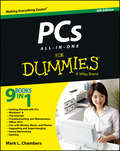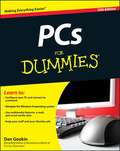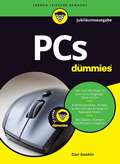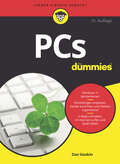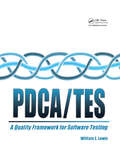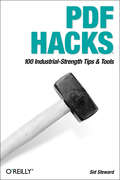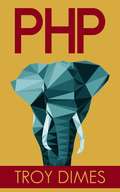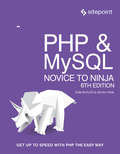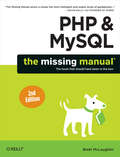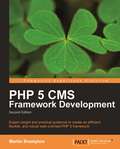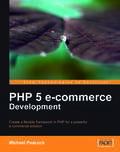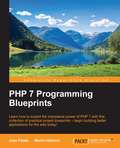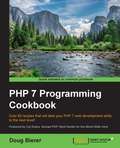- Table View
- List View
PCs All-in-One For Dummies, 6th Edition
by Mark L. ChambersA perfect companion for your PC! Whether you use your PC for work or play, there's a lot to learn and a lot of territory to discover, so take along a good guide. Serving up nine meaty minibooks, this All-in-One guide covers essential PC topics from soup through nuts, including the latest on PC hardware, Windows 8, the Internet, all the tools in Office 2013, digital media, troubleshooting and maintenance, upgrading your PC, home networking, and PC gaming. You'll get to know your PC inside and out and find yourself turning to this terrific resource again and again. This new edition features expanded coverage of home networking and desktop gaming, cool hardware for hardcore gamers, exciting new Windows 8 features, and much more. Nine minibooks provide a comprehensive PC overview and include PC Hardware; Windows 8; The Internet; Troubleshooting and Maintenance; Office 2013; Music, Movies, and Photos; Upgrading and Supercharging; Home Networking; and Gaming Explores step-by-step procedures for using the new Windows 8 operating system Delves into the techy nitty-gritty on things like processor speeds, hard drive capacities, and upgrading Reviews ways to protect your PC from viruses, offers troubleshooting tips, and discusses how to supercharge your PC's performance PCs All-in-One For Dummies, 6th Edition covers everything you need to know to get the most out of your PC.
PCs For Dummies
by Dan GookinThe bestselling PC reference on the planet--now available in its 13th edition Completely updated to cover the latest technology and software, the 13th edition of PCs For Dummies tackles using a computer in friendly, human terms. Focusing on the needs of the beginning computer user, while also targeting those who are familiar with PCs, but need to get up to speed on the latest version of Windows. This hands-on guide takes the dread out of working with a personal computer. Leaving painful jargon and confusing terminology behind, it covers Windows 9 OS, connecting to and using services and data in the cloud, and so much more. Written by Dan Gookin, the original For Dummies author, it tells you how to make a PC purchase, what to look for in a new PC, how to work with the latest operating system, ways to protect your files, what you can do online, media management tips, and even basic topics you're probably too shy to ask a friend about. Determine what you need in a PC and how to set it up Configure your PC, hook up a printer, and connect to the Internet Find your way around Windows 9 OS with ease and confidence Play movies and music, view photos, and explore social media If you're a first-time PC user at home or at work or just need to brush up on the latest technological advancements, the new edition of this bestselling guide gets you up and running fast.
PCs For Dummies 12th Edition
by Dan GookinThe all-time bestselling PC reference, fully updated for the newest technologies! Previous editions of this fun and friendly PC guide have sold more than three million copies, making it the bestselling PC reference in the world. Dan Gookin, the author whose straightforward and entertaining style is the foundation of the For Dummies series, gives you the same easy-to-follow guidance in this edition, fully updated for Windows 8, using the cloud, and all the newest PC bells and whistles. It's perfect for the absolute beginner as well as for anyone switching to the latest hardware and software. Updated with information on all the latest upgrades, this edition of a worldwide bestseller covers all the essentials of using a PC, and presents them in a fun, non-intimidating style Popular technology author Dan Gookin starts at the beginning with all the basics that other books assume everyone knows Covers setting up your PC, exploring the Windows 8 interface, using network hardware and software, getting online and browsing with the newest version of Internet Explorer, setting up an e-mail account, connecting to the cloud, and using cloud-based services Shows you how to install and upgrade programs and manage files and folders Explores working with digital photos, downloading music, watching movies, and participating in social media PCs For Dummies, 12th Edition is the jargon-free, easy-to-use guide to everything you need to know about your PC.
PCs For Dummies Windows 7 Edition
by Dan GookinGet the latest edition of the bestselling PC book on the planet! What better way to make friends with your new PC than with this new edition of the bestselling PC book in the world? PCs For Dummies, Windows 7 Edition explains the latest Windows operating system in a refreshingly jargon-free way that's loaded with good humor and great help. Discover how to make your PC safe for your kids, get in touch with your digital life, use flash drives, learn about green computing, and much more. Dan Gookin, author of the original DOS For Dummies, helped launch the worldwide popularity of the series; his books have been translated in 32 languages and have more than 12 million copies in print This guide gets you up to speed on the latest PC hardware and software and covers all the innovations and changes in Windows 7, all without the boring jargon Covers making your PC safe for kids, organizing your digital life, green computing, storage on memory cards and flash drives, online photo sharing, and much more Make your life easier the Dummies way with PCs For Dummies, Windows 7 Edition.
PCs Simplified
by Elaine MarmelSimply the easiest way to start using a Windows PCIf you want a "show me how, don't tell me why" approach to learning how to use a computer, this is the book for you. Large, full-color screen shots and numbered, step-by-step instructions show you how to get up and running with Windows and the latest hardware add-ons, the Internet, and popular software applications. Learn all the basics plus how to use Office 2010, protect your computer from viruses, sync up mobile devices, and much more.Designed for people who learn best visually, this full-color guide covers basic information for beginning computer users, including how to use Windows 7, multimedia applications, wireless devices, and the InternetUses large screen shots and step-by-step instructions to make learning fast and easyCovers Office 2010, multimedia management, virus protection, popular software applications, common peripherals, and basic securityShows how to integrate the latest wireless technologies and sync mobile devices Visual learners will find this colorful guide shows exactly what to expect at every step and makes learning to use a PC easier than ever before.
PCs für Dummies (Für Dummies)
by Dan GookinDer PC macht nie das, was er soll? Arbeiten am Computer dauern immer viel länger als geplant? Dann sollten Sie dieses Buch lesen. Dan Gookin - Computerexperte der ersten Stunde und Bestseller-Autor - bringt Ihnen geduldig die Tipps und Tricks im Umgang mit dem PC bei. Er spricht von der Maschine als gutem Freund. Fachbegriffe und Technikausdrücke vermeidet er konsequent. Das Buch begleitet Sie vom Auspacken des Computers bis ins Internet. So verlieren Sie schnell die Ehrfurcht vor diesem allgegenwärtigen und im Alltag mittlerweile unverzichtbaren Gerät. Und sind fix auf dem neuesten Stand: Windows 10 und die Cloud werden genauso verständlich behandelt wie der Rest.
PCs für Dummies (Für Dummies)
by Dan GookinDer PC macht nie das, was er soll? Dieses Buch hilft Ihnen dabei, effizient mit Ihrem Computer zu arbeiten. Dan Gookin bringt Ihnen alle wichtigen Grundlagen und viele Tricks im Umgang mit dem PC bei. Er spricht von der Maschine als gutem Freund. Fachbegriffe und Technikausdrücke vermeidet er konsequent. Das Buch begleitet Sie vom Auspacken des Computers bis ins Internet. So legen Sie schnell Berührungsängste vor diesem im Alltag mittlerweile unverzichtbaren Gerät ab und sind fix auf dem neuesten Stand: Windows 11 und die Cloud werden genauso verständlich behandelt wie vieles andere.
PCs: The Missing Manual (Missing Manual)
by David A. Karp Andy RathboneYour vacuum comes with one. Even your blender comes with one. But your PC--something that costs a whole lot more and is likely to be used daily and for tasks of far greater importance and complexity--doesn't come with a printed manual. Thankfully, that's not a problem any longer: PCs: The Missing Manual explains everything you need to know about PCs, both inside and out, and how to keep them running smoothly and working the way you want them to work.A complete PC manual for both beginners and power users, PCs: The Missing Manual has something for everyone. PC novices will appreciate the unassuming, straightforward tutorials on PC basics, such as hooking up a monitor, keyboard, mouse, printer, and scanner. Families will enjoy sections on networking several computers to share an Internet connection, sharing one monitor between two PCs, connecting portable media players, and creating a home theater system. Adventurous PC users will like the clear photos explaining how to take your PC apart and replace or upgrade any failing parts; IT professionals will be grateful to have something to hand to their coworkers who need solid, trusted information about using their PC.In PCs: The Missing Manual, bestselling computer author Andy Rathbone delivers simple, reliable advice on the kinds of things PC users confront every day. He shows you how to connect and configure today's must-have devices (including digital cameras, portable music players, digital camcorders, and keychain drives); burn CDs and DVDs; scan and fax documents, and more. His section on the Internet explains how to choose the best Internet Service Provider and web browser for your needs; send email; find information quickly on the Web; share photos online; set up a blog; set up a webcam; access TV and radio through the Internet; and shop safely online. And Rathbone delivers plenty of guidance on keep your privacy and your PC safe by installing firewalls, creating safe passwords, running antivirus software, removing spyware and adware, and backing up important files.
PDCA/Test
by William LewisMost manuals assume software testing is being performed as part of a well-defined, structured development cycle based on clearly stated requirements and standards. Unfortunately, this is not often the case in the real world. Indeed, the one true constant in software development is change.PDCA/TEST presents a continuous quality framework bas
PDF Explained: The ISO Standard for Document Exchange
by John WhitingtonAt last, here’s an approachable introduction to the widely used Portable Document Format. PDFs are everywhere, both online and in printed form, but few people take advantage of the useful features or grasp the nuances of this format. This concise book provides a hands-on tour of the world’s leading page-description language for programmers, power users, and professionals in the search, electronic publishing, and printing industries. Illustrated with lots of examples, this book is the documentation you need to fully understand PDF.Build a simple PDF file from scratch in a text editor Learn the layout and content of a PDF file, as well as the syntax of its objectsExamine the logical structure of PDF objects, and learn how pages and their resources are arranged into a documentCreate vector graphics and raster images in PDF, and deal with transparency, color spaces, and patternsExplore PDF operators for building and showing text stringsGet up to speed on bookmarks, metadata, hyperlinks, annotations, and file attachmentsLearn how encryption and document permissions work in PDFUse the pdftk program to process PDF files from the command line
PDF Forms Using Acrobat and LiveCycle Designer Bible
by Ted Padova Angie OkamotoThis comprehensive guide to creating fillable forms with the latest release of Adobe Acrobat is packed with real-world insights and techniques gained from daily use of Adobe Acrobat and Adobe LiveCycle Designer under business deadline situations. You'll get step-by-step instructions that show you how to easily create and implement interactive PDF forms using both Adobe Acrobat and Adobe LiveCycle Designer.Note: CD-ROM/DVD and other supplementary materials are not included as part of eBook file.
PDF Hacks: 100 Industrial-Strength Tips & Tools
by Sid StewardPDF--to most of the world it stands for that rather tiresome format used for documents downloaded from the web. Slow to load and slower to print, hopelessly unsearchable, and all but impossible to cut and paste from, the Portable Document Format doesn't inspire much affection in the average user. But PDFs done right is another story. Those who know the ins and outs of this format know that it can be much more than electronic paper. Flexible, compact, interactive, and even searchable, PDF is the ideal way to present content across multiple platforms.PDF Hacks unveils the true promise of Portable Document Format, going way beyond the usual PDF as paged output mechanism. PDF expert Sid Steward draws from his years of analyzing, extending, authoring, and embellishing PDF documents to present 100 clever hacks--tools, tips, quick-and-dirty or not-so-obvious solutions to common problems. PDF Hacks will show you how to create PDF documents that are far more powerful than simple representations of paper pages. The hacks in the book cover the full range of PDF functionality, from the simple to the more complex, including generating, manipulating, annotating, and consuming PDF information. You'll learn how to manage content in PDF, navigate it, and reuse it as necessary. Far more than another guide to Adobe Acrobat, the book covers a variety of readily available tools for generating, deploying, and editing PDF. The little-known tips and tricks in this book are ideal for anyone who works with PDF on a regular basis, including web developers, pre-press users, forms creators, and those who generate PDF for distribution. Whether you want to fine-tune and debug your existing PDF documents or explore the full potential the format offers, PDF Hacks will turn you into a PDF power user.
PEM Fuel Cells with Bio-Ethanol Processor Systems
by Rachid Outbib Diego Feroldi Marta S. BasualdoAn apparently appropriate control scheme for PEM fuel cells may actually lead to an inoperable plant when it is connected to other unit operations in a process with recycle streams and energy integration. PEM Fuel Cells with Bio-Ethanol Processor Systems presents a control system design that provides basic regulation of the hydrogen production process with PEM fuel cells. It then goes on to construct a fault diagnosis system to improve plant safety above this control structure. PEM Fuel Cells with Bio-Ethanol Processor Systems is divided into two parts: the first covers fuel cells and the second discusses plants for hydrogen production from bio-ethanol to feed PEM fuel cells. Both parts give detailed analyses of modeling, simulation, advanced control, and fault diagnosis. They give an extensive, in-depth discussion of the problems that can occur in fuel cell systems and propose a way to control these systems through advanced control algorithms. A significant part of the book is also given over to computer-aided engineering software tools that can be used to evaluate the dynamic performance of the overall plant. PEM Fuel Cells with Bio-Ethanol Processor Systems is intended for use by researchers and advanced students on chemical, electrical-electronic and mechanical engineering courses in which dynamics and control are incorporated with the traditional steady-state coverage of flowsheet synthesis, engineering economics and optimization.
PHP
by Troy Dimes Caroline L.El Preprocesador Hipertexto, comúnmente llamado PHP, es uno de los lenguajes de programación cliente-servidor de códigos abiertos más ampliamente usados. Sitios web famosos incluyendo Facebook, Yahoo, Friendster, WorldPress y Flickr son arrancados por PHP. Este libro proporciona una breve introducción de programación en PHP. En éste, a usted se le enseñarán conceptos importantes de PHP, comenzando con lo básico y moviéndose a un PHP orientado a objetos más avanzados.
PHP
by Troy Dimes Consalvo CattutoPHP è uno dei più diffusi linguaggi di programmazione open source lato server. Volete imparare a programmare in PHP e volete farlo rapidamente ? Siete nuovi alla programmazione o volete rispolverare un po' di nozioni ? Se è così questo libro è una fantastica risorsa per voi. PHP è uno dei più diffusi linguaggi di programmazione open source lato server, se siete interessati a cominciare a programmare e siete alla ricerca di qualche nozione base sul linguaggio, allora questo libro fa per voi! Siti web famosi come Facebook e Yahoo poggiano su PHP, in questo senso PHP può essere considerato il linguaggio del mondo! Sono inclusi concetti base, esempi ed esercizi. Il libro copre concetti chiave partendo dalle basi e arrivando ad argomenti avanzati come la programmazione ad oggetti in PHP spiegando e dimostrando tutto durante a lettura. Sarete in grado di iniziare a programmare in PHP in poco tempo. Ottimo per i principianti o per quelli che hanno qualche esperienza di programmazione. Questo è un libro scritto da un esperto per persone come voi. Potreste conoscere già qualcosa di programmazione ma voler imparare ancora di più. Troverete questo libro così semplice da assimilare, e poiché vengono forniti aiuti passo-passo non avrete problemi durante la lettura. Ecco alcune delle cose che imparerete: *Cosa è PHP, perché dovreste usarlo e come funziona esattamente *Come preparare il vostro computer per poter programmare in PHP (screenshot inclusi) *Come creare facilmente e velocemente le vostre applicazioni PHP *Molti utili trucchi e scorciatoie su come programmare facilmente in PHP *Molto altro ...
PHP & MySQL For Dummies
by Janet ValadeHere's what Web designers need to know to create dynamic, database-driven Web sites To be on the cutting edge, Web sites need to serve up HTML, CSS, and products specific to the needs of different customers using different browsers. An effective e-commerce site gathers information about users and provides information they need to get the desired result. PHP scripting language with a MySQL back-end database offers an effective way to design sites that meet these requirements. This full updated 4th Edition of PHP & MySQL For Dummies gets you quickly up to speed, even if your experience is limited. Explains the easy way to install and set up PHP and MySQL using XAMPP, so it works the same on Linux, Mac, and Windows Shows you how to secure files on a Web host and how to write secure code Packed with useful and understandable code examples for Web site creators who are not professional programmers Fully updated to ensure your code will be compliant based on PHP 5. 3 and MySQL 5. 1. 31 Provides clear, accurate code examples PHP & MySQL For Dummies, 4th Edition provides what you need to know to create sites that get results. Note: CD-ROM/DVD and other supplementary materials are not included as part of eBook file.
PHP & MySQL Web Development All-in-One Desk Reference For Dummies
by Janet Valade Bill Ballad Tricia BalladIf you want to build dynamic Web sites that encourage users to interact with them, PHP and MySQL are among the best tools you'll find. PHP is a scripting language designed specifically for use on the Web, while MySQL is a database management system that works with it perfectly. Best of all, they're free. It's hard to beat that combination!PHP & MySQL Web Development All-in-One Desk Reference For Dummies is kind of one-stop shopping for the information you need to get up and running with these tools and put them to good use. It's divided into six handy minibooks that cover setting up your environment, PHP programming, using MySQL, security, PHP extensions, and PHP Web applications. They make it easy to create a Web site where visitors can sign on, use shopping carts, complete forms, and do business with your business.It's easy to find what you need in this handy guide. You'll discover how to:Find and acquire all the tools you need and set up your development environmentBuild PHP scripts to make your Web site workCreate a MySQL database that visitors can accessSummarize and sort data resultsDesign and implement user access controlBuild a shopping cart applicationCreate extensions that make your site more usefulWith PHP & MySQL Web Development All-in-One Desk Reference For Dummies by your side, you'll be a Web site guru before you know it!
PHP & MySQL: Get Up to Speed With PHP the Easy Way
by Kevin Yank Tom ButlerPHP & MySQL: Novice to Ninja, 6th Edition is a hands-on guide to learning all the tools, principles, and techniques needed to build a fully functional application using PHP & MySQL. Comprehensively updated to cover PHP 7 and modern best practice, this practical and fun book covers everything from installing PHP and MySQL through to creating a complete online content management system. You'll learn how to: Install PHP & MySQL on Windows, Mac OS X, or LinuxGain a thorough understanding of PHP syntaxUse object oriented programming techniquesMaster database design principles and SQLDevelop robust websites that can handle high levels of trafficBuild a working content management system (CMS)And much more!
PHP & MySQL: The Missing Manual, Second Edition
by Brett McLaughlinIf you can build websites with CSS and JavaScript, this book takes you to the next level—creating dynamic, database-driven websites with PHP and MySQL. Learn how to build a database, manage your content, and interact with users. With step-by-step tutorials, this completely revised edition gets you started with expanded coverage of the basics and takes you deeper into the world of server-side programming.The important stuff you need to know:Get up to speed quickly. Learn how to install PHP and MySQL, and get them running on both your computer and a remote server.Gain new techniques. Take advantage of the all-new chapter on integrating PHP with HTML web pages.Manage your content. Use the file system to access user data, including images and other binary files.Make it dynamic. Create pages that change with each new viewing.Build a good database. Use MySQL to store user information and other data.Keep your site working. Master the tools for fixing things that go wrong.Control operations. Create an administrative interface to oversee your site.
PHP 5 CMS Framework Development - 2nd Edition
by Martin BramptonThe book includes extensive discussion of the design issues, and how to overcome them in the framework. Each chapter of the book focuses on a particular requirement of the framework. The book will not present the total code for a framework, which requires many thousands of lines. But it does show the parts that raise critical design or implementation issues. For these, detailed explanation is given, leaving the less problematic parts to the code download itself. If you are a professional PHP developer who wants to know more about web oriented frameworks and content management systems, this book is for you. Whether you already use an in-house developed framework or are developing one, or if you are simply interested in the issues involved in this demanding area, you will find discussion ranging from design issues to detailed coding solutions in this book. You are expected to have experience working with PHP 5 object-oriented programming. Examples in the book will run on any recent version of PHP 5, including 5.3.
PHP 5 Social Networking
by Michael PeacockThis book is a fast-paced tutorial focusing on creating a Social Networking framework through an ongoing case study. It presents a lot of real-world code, with comprehensive explanation and discussion. With each chapter, the Social Networking framework is extended, with more functionality being added as we progress through the book.This book is primarily aimed at PHP developers, but is suitable for any web developers looking to expand their knowledge and understanding of Social Networking concepts. Intermediate knowledge of PHP and object-oriented programming is assumed, along with a basic knowledge of MySQL.
PHP 5 e-commerce Development
by Michael PeacockThis is a fast-paced tutorial focusing on creating a framework and using it to build an online store through an ongoing case study. Later chapters include examples to illustrate how easily the framework can be adapted for different situations. The framework and code are enhanced and built upon with each chapter, adding more and more functionality. If you are a web developer, or anyone looking to increase your understanding of e-commerce site development, this book is for you. Primarily aimed at PHP developers, it is suitable for any web developer interested in enhancing their e-commerce knowledge, or developers looking to move towards PHP. Intermediate knowledge of PHP development and object-oriented programming is assumed, and basic knowledge of e-commerce principles will be of benefit too.
PHP 7 Data Structures and Algorithms
by Mizanur RahmanIncrease your productivity by implementing data structures About This Book • Gain a complete understanding of data structures using a simple approach • Analyze algorithms and learn when you should apply each solution • Explore the true potential of functional data structures Who This Book Is For This book is for those who want to learn data structures and algorithms with PHP for better control over application-solution, efficiency, and optimization. A basic understanding of PHP data types, control structures, and other basic features is required What You Will Learn • Gain a better understanding of PHP arrays as a basic data structure and their hidden power • Grasp how to analyze algorithms and the Big O Notation • Implement linked lists, double linked lists, stack, queues, and priority queues using PHP • Work with sorting, searching, and recursive algorithms • Make use of greedy, dynamic, and pattern matching algorithms • Implement tree, heaps, and graph algorithms • Apply PHP functional data structures and built-in data structures and algorithms In Detail PHP has always been the the go-to language for web based application development, but there are materials and resources you can refer to to see how it works. Data structures and algorithms help you to code and execute them effectively, cutting down on processing time significantly. If you want to explore data structures and algorithms in a practical way with real-life projects, then this book is for you. The book begins by introducing you to data structures and algorithms and how to solve a problem from beginning to end using them. Once you are well aware of the basics, it covers the core aspects like arrays, listed lists, stacks and queues. It will take you through several methods of finding efficient algorithms and show you which ones you should implement in each scenario. In addition to this, you will explore the possibilities of functional data structures using PHP and go through advanced algorithms and graphs as well as dynamic programming. By the end, you will be confident enough to tackle both basic and advanced data structures, understand how they work, and know when to use them in your day-to-day work Style and approach An easy-to-follow guide full of examples of implementation of data structures and real world examples to solve the problems faced. Each topic is first explained in general terms and then implemented using step by step explanation so that developers can understand each part of the discussion without any problem.
PHP 7 Programming Blueprints
by Jose Palala Martin HelmichLearn how to exploit the impressive power of PHP 7 with this collection of practical project blueprints - begin building better applications for the web today! About This Book * Don't just learn PHP 7 - follow a diverse range of practical knowledge to get started quickly * Take advantage of PHP 7's newest features - and find out how to use them to solve real development challenges * Put PHP to work for performance and scalability - we'll show you how, you do it! Who This Book Is For The book is for web developers, PHP consultants, and anyone who is working on multiple projects with PHP. Basic knowledge of PHP programming is assumed. What You Will Learn * Build versatile projects using the newest features PHP 7 has to offer * Learn how to use PHP 7's event-driven asynchronous features * Find out how to improve the performance of your code with effective techniques and design patterns * Get to grips with backend development and find out how to optimize session handling * Learn how to use the PHP 7 Abstract Syntax Tree to improve the quality of your code and make it more maintainable * Find out how to build a RESTful web service * Build your own asynchronous microservice In Detail When it comes to modern web development, performance is everything. The latest version of PHP has been improvised and updated to make it easier to build for performance, improved engine execution, better memory usage, and a new and extended set of tools. If you're a web developer, what's not to love? This guide will show you how to make full use of PHP 7 with a range of practical projects that will not only teach you the principles, but also show you how to put them into practice. It will push and extend your skills, helping you to become a more confident and fluent PHP developer. You'll find out how to build a social newsletter service, a simple blog with a search capability using Elasticsearch, as well as a chat application. We'll also show you how to create a RESTful web service, a database class to manage a shopping cart on an e-commerce site and how to build an asynchronous microservice architecture. With further guidance on using reactive extensions in PHP, we're sure that you'll find everything you need to take full advantage of PHP 7. So dive in now! Style and approach This product focuses on helping developers build projects from scratch. But more than that, each project will help the reader to learn a new facet or feature of PHP 7 - it means the reader really will 'learn by doing.'
PHP 7 Programming Cookbook
by Doug BiererOver 80 recipes that will take your PHP 7 web development skills to the next level! About This Book * This is the most up-to-date book in the market on PHP * It covers the new features of version 7.x, best practices for server-side programming, and MVC frameworks * The recipe-based approach will allow you to explore the unique capabilities that PHP offers to web programmers Who This Book Is For If you are an aspiring web developer, mobile developer, or backend programmer, then this book is for you as it will take your PHP programming skills to next level. Basic knowledge of PHP programming is assumed. What You Will Learn * Use advanced PHP 7 features, such as the Abstract Syntax Tree, Uniform Variable Syntax, Scalar Type Hints, Generator Delegation, Anonymous Classes, and the Context Sensitive Lexer * Discover where and when PHP 5 code needs to be re-written to avoid backwards-compatibility breaks * Improve the overall application security and error handling by taking advantage of classes that implement the new throwable interface * Solve practical real-world programming problems using PHP 7 * Develop middle-wareclasses that allow PHP developers to gluedifferent open source libraries together seamlessly * Define and Implement PSR-7 classes * Create custom middleware using PSR-7 compliant classes * Test and debug your code, and get to know the best practices In Detail PHP 7 comes with a myriad of new features and great tools to optimize your code and make your code perform faster than in previous versions. Most importantly, it allows you to maintain high traffic on your websites with low-cost hardware and servers through a multithreading web server. This book demonstrates intermediate to advanced PHP techniques with a focus on PHP 7. Each recipe is designed to solve practical, real-world problems faced by PHP developers like yourself every day. We also cover new ways of writing PHP code made possible only in version 7. In addition, we discuss backward-compatibility breaks and give you plenty of guidance on when and where PHP 5 code needs to be changed to produce the correct results when running under PHP 7. This book also incorporates the latest PHP 7.x features. By the end of the book, you will be equipped with the tools and skills required to deliver efficient applications for your websites and enterprises. Style and approach This book takes a recipe-based approach, with real-world examples that can serve as building blocks for a larger application. Each recipe is self-contained with no external dependencies. This book follows a problem-solution strategy so you understand how to deal with various scenarios you may encounter while using PHP 7 in your daily activities.
